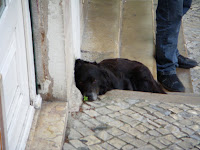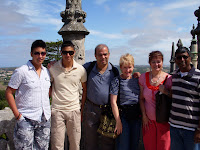

The next morning we got up early to make our reserved 3-hour parking slot at Greenway House overlooking the River Dart. Agatha Christie was born and raised in Torquay, and she bought Greenway House as a summer home. The first home built on this site was in 1523. After many owners and renovations, Dame Agatha (aka Mrs Mallowan) remodelled Greenway House "for modern living" in 1938.


As Agatha Christie fans, we loved the home visit. We then strolled the grounds visiting the boat / bath house, a Kwan Yin, and a Bridget McCrum outdoor sculpture.


We took a car ferry to the picturesque town of Dartmouth. We drove directly to an American war memorial erected in 1954 and dedicated to the people of South Hams who were evacuated (some never to return) so that D-Day preparation exercises could be performed. This memorial also commemorates the almost one thousand (exact number unknown) American soldiers who lost their lives one night when they were surprised by an attack by 9 German E-Boats. In the confusion, lives were also lost from "friendly fire". This event was kept secret for 40 years and "Project Tiger" casualties were purposely mixed in with the D-Day losses.


Upon returning to Torquay, Gordon led us on a vigorous hour walk down to the beach through wooded paths and back up some very steep hills - enough to get the heart racing without running.



































 Cobblestone Alley in Patershol
Cobblestone Alley in Patershol  Demolition from the Inside
Demolition from the Inside







